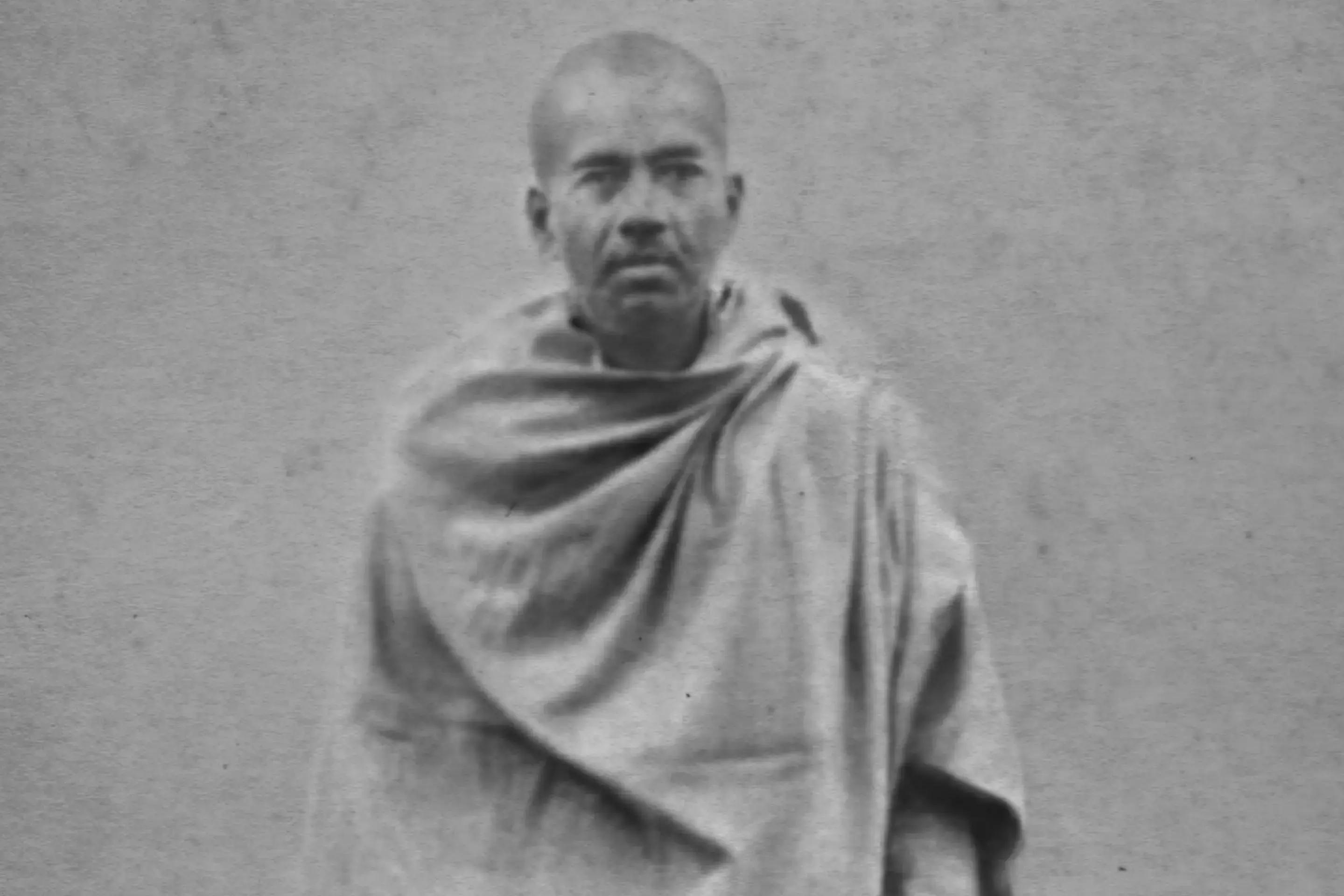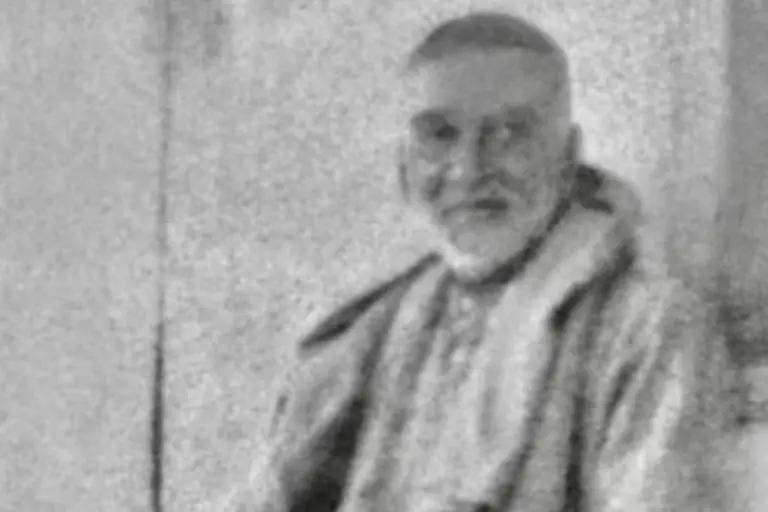Swami Tapovan Maharaj


Swami Tapovan Maharaj
Jewel of the Himalayas
Swami Tapovan Maharaj, Vidya Guru of Swami Chinmayananda, was a towering figure, renowned throughout the Himalayas as a Knower of Truth. He was called Himavat Vibhuti – Jewel of the Himalayas – and was sought after as a Teacher and Saint. Swami Tapovan Maharaj was a strict ascetic who lived in a simple hut in Uttarkashi, abiding in the peace of his realisation, stepping away only for solitary wanderings in the Himalayan mountains.
Lovingly addressed by the Chinmaya family as Parama Guru, he holds a place of supreme reverence in the hearts of all.
Swami Chinmayananda said of his Guru, “He was a God without temple, a Veda without language.”
His mastery of the Vedas and the Upanishads was legendary, as were his love of nature and his tireless compassion for spiritual aspirants, wrestling with the Scriptures and householders struggling to maintain a spiritual focus in daily life.
Spiritual Journey
1924 Onwards – His life as a Sannyasi

Journeying through Prayagraj and Ayodhya, he reached Rishikesh, where he was formally initiated into Sannyasa by Swami Janardanagiri, Head of Kailash Ashram. That summer, he undertook a spiritual pilgrimage across the Himalayas - trekking to Uttarkashi, Gangotri, Kailash and beyond. These journeys are vividly captured in his beautiful books, Wandering in the Himalayas and Ishwara Darshan. They present pure Vedanta through ecstatic and poetic narratives.
Until 1907 - Early Life

A brilliant and devout Vedantin from a young age, Swami Tapovan Maharaj found the conventional education system stifling and unsuited to his temperament. Displeasing his ambitious father, he dropped out of school and chose a path of self-learning and spiritual inquiry. Home-schooled and largely self-taught, he mastered both Malayalam and Sanskrit, earning recognition as a linguistic prodigy.
1910 – Informal Adoption of a Sannyasi’s Life

Swami Tapovan Maharaj endured the loss of both his parents before turning 21. Even then, he was known for his deep contemplative nature and poetic flair. Though not yet formally initiated, he had already adopted the serene and austere lifestyle of a Sannyasi. He briefly studied scriptural texts under Swami Satyananda in Bhavnagar, Gujarat before returning to Palakkad, Kerala.
1912 - Public Speaker, Private Sannyasi

Despite his disinterest in worldly affairs, he was compelled by circumstance to shoulder family responsibilities. During this period, he actively participated in public life, delivering talks on politics, religion and Vedanta. A gifted writer, he regularly contributed articles and essays to newspapers and journals, articulating spiritual and philosophical ideas with precision and poetic grace.
1923 – The Path of Sannyasa

With his familial duties fulfilled, particularly after his brother qualified to practise law, Swami Tapovan Maharaj renounced worldly life. He left home and stayed briefly with Swami Hridayananda in Panchavati, near Nashik. On the banks of the Narmada, he initiated himself into the life of a Sannyasi, donning the ochre robes of renunciation.
1924 Onwards – His life as a Sannyasi

Journeying through Prayagraj and Ayodhya, he reached Rishikesh, where he was formally initiated into Sannyasa by Swami Janardanagiri, Head of Kailash Ashram. That summer, he undertook a spiritual pilgrimage across the Himalayas - trekking to Uttarkashi, Gangotri, Kailash and beyond. These journeys are vividly captured in his beautiful books, Wandering in the Himalayas and Ishwara Darshan. They present pure Vedanta through ecstatic and poetic narratives.
Until 1907 - Early Life

A brilliant and devout Vedantin from a young age, Swami Tapovan Maharaj found the conventional education system stifling and unsuited to his temperament. Displeasing his ambitious father, he dropped out of school and chose a path of self-learning and spiritual inquiry. Home-schooled and largely self-taught, he mastered both Malayalam and Sanskrit, earning recognition as a linguistic prodigy.
1910 – Informal Adoption of a Sannyasi’s Life

Swami Tapovan Maharaj endured the loss of both his parents before turning 21. Even then, he was known for his deep contemplative nature and poetic flair. Though not yet formally initiated, he had already adopted the serene and austere lifestyle of a Sannyasi. He briefly studied scriptural texts under Swami Satyananda in Bhavnagar, Gujarat before returning to Palakkad, Kerala.
1912 - Public Speaker, Private Sannyasi

Despite his disinterest in worldly affairs, he was compelled by circumstance to shoulder family responsibilities. During this period, he actively participated in public life, delivering talks on politics, religion and Vedanta. A gifted writer, he regularly contributed articles and essays to newspapers and journals, articulating spiritual and philosophical ideas with precision and poetic grace.
1923 – The Path of Sannyasa

With his familial duties fulfilled, particularly after his brother qualified to practise law, Swami Tapovan Maharaj renounced worldly life. He left home and stayed briefly with Swami Hridayananda in Panchavati, near Nashik. On the banks of the Narmada, he initiated himself into the life of a Sannyasi, donning the ochre robes of renunciation.
1924 Onwards – His life as a Sannyasi

Journeying through Prayagraj and Ayodhya, he reached Rishikesh, where he was formally initiated into Sannyasa by Swami Janardanagiri, Head of Kailash Ashram. That summer, he undertook a spiritual pilgrimage across the Himalayas - trekking to Uttarkashi, Gangotri, Kailash and beyond. These journeys are vividly captured in his beautiful books, Wandering in the Himalayas and Ishwara Darshan. They present pure Vedanta through ecstatic and poetic narratives.
Divine Harmony with Nature
The perfect Seer, sees Perfection

Pilgrim of the Eternal Himalayas
To Swami Tapovan Maharaj, nature was Divinity manifested, worthy of eternal worship. The roaring Ganga was his Divine Mother, and his beloved Kashi Vishwanath, was the supreme Lord and Father. The forests of Uttarkashi and Gangotri were his temples. His Hymn to Ganga and Sri Soumya Kaseesa Stotram are masterpieces of erudition and devotion.
Swami Tapovan Maharaj wrote exquisitely descriptive spiritual ‘travelogues’ of his pilgrimages to holy places including Rishikesh, Uttarkashi, Yamunotri, Gangotri, Kedarnath, Badrinath, Amarnath, Gaumukh, Kailash and Manasarovar. These journeys are vividly captured in his beautiful books, Wandering in the Himalayas and Ishwara Darshan. They present pure Vedanta through ecstatic and poetic narratives.

Master of Renunciation
Swami Tapovan Maharaj was revered across the Himalayas for his ascetic life and profound scriptural knowledge. Shunning all comforts, he lived in a simple one-room hut with only a blanket and water pot. He ate a basic meal from the Kali Kambli Wala Ashram, often washing off the spices.
On his travels, he relied solely on divine providence for food and shelter, walking barefoot through snow and fasting when bhiksha was unavailable, all the while immersed in the beauty of creation. In his later years, he remained in Uttarkashi or Gangotri, never returning to the plains.


The Silent Teacher of Non-Dual Truth
One who has realised his own Universal Nature is called a Mahatma. Swami Tapovan Maharaj was such a Mahatma revelling in the Truth of non-duality. Swami Tapovan Maharaj had just a few students, as he was an uncompromising teacher, though many seekers and sadhus sought his wisdom in interpreting the Brahmasutras and the Upanishads, along with advice for advancing their sadhana. Swami Chinmayananda was one of a very small group of dedicated students studying with him in the early 1950’s.
Despite his apparent toughness, Swami Tapovan Maharaj was compassion personified. He wrote to many householders with guidance for their spiritual progress having complete understanding of the obstacles and barriers they might face.
Authored by Parama Guru
Books that Speak
Gallery



Central Chinmaya Mission Trust
Saki Vihar Road, Powai, Mumbai - 400 072.
Tel : +91-22-2803 4900
E-mail : ccmt@chinmayamission.com